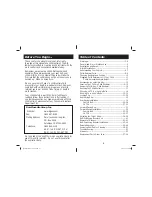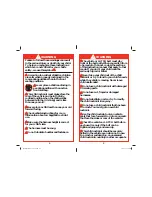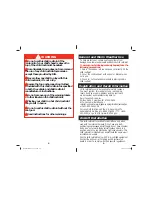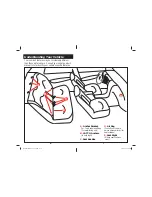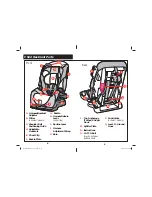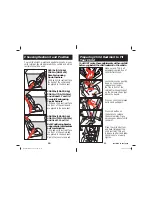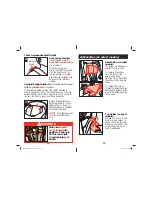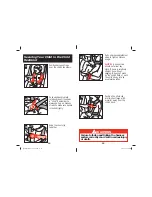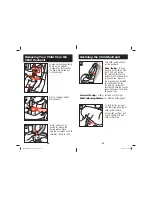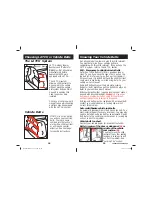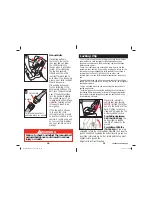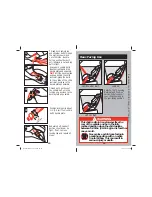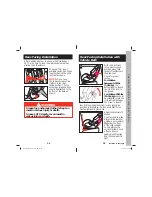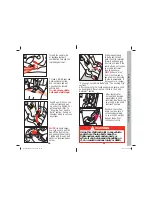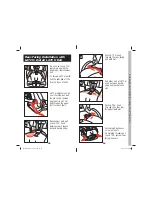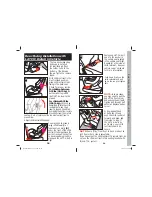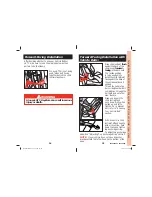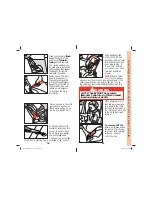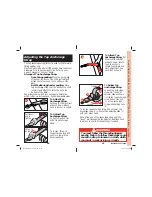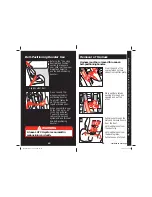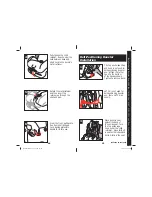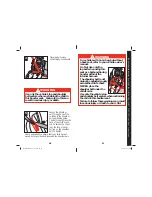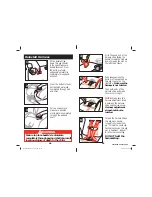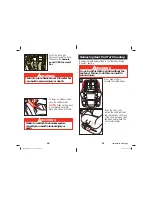
21
20
Buckle
Twist vehicle seat belt
and latch plate (or buckle)
Latch plate
WARNING
!
Failure to check and adjust the manual belt
as described above could result in serious
injury or death.
1
2
Manual Belts
Manual lap belts are
common in the center
rear seat and can allow
the child restraint to
loosen when it is tilted or
jarred. After tightening
the lap belt securely,
tilt and push the child
restraint forward and to
both sides. If no loosening
occurs, your child restraint
should be secure.
If loosening does occur,
try the following: If the
buckle plate slides on the
belt, turn the buckle plate
over. If the buckle slides,
turn the buckle. Refasten
the vehicle lap belt. The
release button should face
out
after twisting so that
it is easy to reach in an
emergency.
If the lap belt continues
to loosen, the child
restraint must be moved
to another location in the
vehicle. A locking clip will
not correct this problem;
see your vehicle owner’s
manual.
Locking Clip
You will rarely need to use a locking clip except in some older
vehicles. Built in child restraint locking systems have been
required in vehicles since 1996, and many vehicles had these
features even earlier.
Check your vehicle owner’s manual to learn how to use the
systems in your vehicle. If you need a locking clip, return to the
store where you purchased this child restraint to purchase a
locking clip or call us at 1-800-544-1108 to order one.
Locking clips from any child restraint manufacturer are okay to
use.
Remove the locking clip when the vehicle seat belt is not being
used with the child restraint. A locking clip will not fix all types of
seat belt problems.
You do not need a locking clip when using this seat as a belt-
positioning booster.
The following directions describe installing the child restraint
rear-facing. Same steps apply for forward facing, except install
the restraint forward facing and thread the vehicle belt in the
forward-facing belt path.
continued on next page.
Place child restraint in
vehicle seat rear-facing.
NOTE:
Attach the tether
hook to the bottom of the
base. Tighten to remove
slack. See “Adjusting the Top
Anchorage Strap” section.
For children between
5-22 lbs (2.3-10 kg), the
bottom level to ground
line MUST be level to the
ground.
For children 22-35 lbs
(10.1-16 kg) and can sit up
unassisted, rotate the child restraint between the 2 level to
ground lines. Start by making the bottom level to ground line
level, then rotate seat up. Do Not rotate past the top most
upright level to ground line.
Adjust child restraint if needed.
4360-2335
Most Upright Level to Ground Line
Most
Recl
ined
Level
to Gr
ound Li
ne
1
4360-2335
Most
Upright L
evel to G
round
Line
Mo
st Re
clin
ed L
eve
l to
Gr
oun
d Line
4360-2335
Most Upright Level to Ground Line
4358-6547 US All in One.indd 23-24
4358-6547 US All in One.indd 23-24
1/20/14 3:19 PM
1/20/14 3:19 PM


